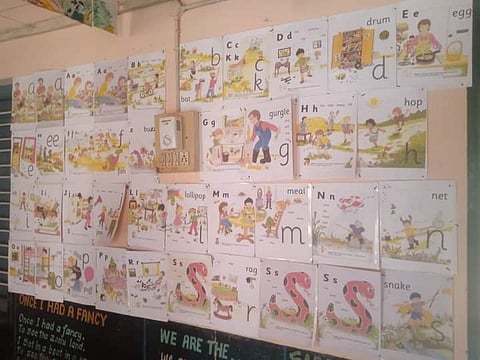

Private and international schools across India stress on experiential learning these days. Not just schools, the new National Education Policy too stresses on experiential learning and hands-on learning. Though these concepts might sound new to the Indian education system, there are a few teachers in government schools across the country who have already been using these strategies for years now. Thimmappa Kodlady is one such teacher who is implementing experiential and hands-on learning for students at the Government Lower Primary School in Malethodi near Puttur in Udupi district.
The school Thimmappa teaches in is already well recognised for its unique methods of learning, methods that he has designed and adopted over a period of ten years. While he employs experiential learning for most of the subjects, his way of teaching English is what his students love. When we ask him why he chose to teach English in this unique method, he says, "A lot of kids drop out of high school or college because they don't understand what is being taught in English or because it is difficult to learn the language. But what if we teach them English when they are in lower primary or primary school? The fact of the matter is, it isn't a big deal to learn English. That's why I decided to train my students in English in a unique way so that they don't feel bored to learn the language."
But Thimmappa did not design or develop these methods overnight. Whenever the education department or any private organisation organised a workshop or a teacher training programme, Thimmappa attended it without fail. That's how he derived some of these methods and designed his own content and his way of teaching this language. "I don't start with the Alphabet," says Thimmappa. What? How does one teach the language without the basics? He laughs and answers, "I teach them the sounds of these letters first and once they are perfect with the sounds, I move to the letters. Children will learn it faster if we teach them the sounds first. While this is achieved, what children learn easily is to write the spellings. Even long and complex spellings are written easily by children."
Unlike other schools where the walls of each primary classroom has an Alphabet poster with pictures of apples and elephants, Thimmappa's classroom has pictures of the sounds and the respective animal/bird. For instance, if the word is 'quack', the poster includes the letters 'qu' and the photo of a duck. The school has turned its classroom into a beautiful learning space, equipped with paintings and informative posters. "My students can easily read their textbooks and English novels, however big they are. This is because we start with sounds and phonetics. Similarly, as they go up to higher class, we teach them grammar through English lessons. At the end of the lesson, we do a detailed analysis to recollect what they have learnt in terms of grammar."
While this happens inside the classroom, Thimmappa ensures that these children continue to learn the language in a fun way even during their free time while out on the school corridors. To achieve this, he has made posters of high-frequency words used in English and hung them up along the corridors. Whenever children have some free time or even before school begins, they are encouraged to read these words out loud. He says, "I have adopted this method while teaching Kannada too. Apart from attending classes, children are divided into groups and are involved in reporting on some of the important school meetings or School Development Monitoring Committee (SDMC) meetings. These students have to be present during the meeting and write a summary on what has been discussed and submit the report the next day."
There are only two teachers in the Government Lower Primary School in Malethodi, including Thimmappa. "We have 35 students in total and I think two teachers are enough to teach them. But every now and then, we have guest teachers who visit our school. However, schools have been shut since last year and it has been difficult to teach our students using the methods that we use in school. We hope that the normalcy resumes soon and the schools open. Otherwise, students will miss out on important learning or development," he concludes.
